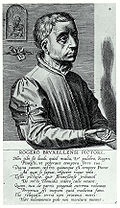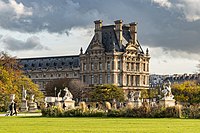
Fichier d’origine (1 859 × 540 pixels, taille du fichier : 191 kio, type MIME : image/jpeg)
Ce fichier et sa description proviennent de Wikimedia Commons.
Description
| Rogier van der Weyden : Triptyque de la famille Braque
|
|||||||||||||||||||||||||
|---|---|---|---|---|---|---|---|---|---|---|---|---|---|---|---|---|---|---|---|---|---|---|---|---|---|
| Artiste |
artist QS:P170,Q68631 |
||||||||||||||||||||||||
| Titre |
Triptyque de la famille Braque . |
||||||||||||||||||||||||
| Type d'objet |
retable / triptyque / peinture |
||||||||||||||||||||||||
| Genre |
art sacré |
||||||||||||||||||||||||
| Personnes représentées | |||||||||||||||||||||||||
| Date | vers 1450-1452 | ||||||||||||||||||||||||
| Technique / matériaux | huile sur panneau de chêne | ||||||||||||||||||||||||
| Dimensions |
hauteur : 41 cm ; largeur : 137 cm dimensions QS:P2048,41U174728 dimensions QS:P2049,137U174728 |
||||||||||||||||||||||||
| Collection |
institution QS:P195,Q19675 |
||||||||||||||||||||||||
| Lieu actuel | |||||||||||||||||||||||||
| Numéro d’inventaire |
RF 2063 |
||||||||||||||||||||||||
| Notes |
Provenance : entre 1450 et 1452date QS:P,+1450-00-00T00:00:00Z/8,P1319,+1450-00-00T00:00:00Z/9,P1326,+1452-00-00T00:00:00Z/9 : commandé par Jehan Braque (†1452) & Catherine de Brabant, Tournai1497 (au plus tard) date QS:P,+1497-00-00T00:00:00Z/7,P1326,+1497-00-00T00:00:00Z/9 : Catherine BraqueDate inconnue : acquis par Jehan Villain date QS:P,+1586-00-00T00:00:00Z/7,P1326,+1586-00-00T00:00:00Z/9 : VillainDate inconnue : acquis par Jérôme de Brabant |
||||||||||||||||||||||||
| Références |
|
||||||||||||||||||||||||
| Autorité | |||||||||||||||||||||||||
| Source / photographe |
Web Gallery of Art: reference_wga QS:P973,"http://www.wga.hu/html/w/weyden/rogier/10braque/0braque.html" |
||||||||||||||||||||||||
| Autres versions |
|
||||||||||||||||||||||||
Conditions d’utilisation
|
Ceci est une reproduction photographique fidèle d'une œuvre d'art originale en deux dimensions. L'œuvre d'art elle-même est dans le domaine public pour la raison suivante :
La position officielle de la Fondation Wikimedia est que « les représentations fidèles des œuvres d'art du domaine public en deux dimensions sont dans le domaine public et les exigences contraires sont une attaque contre le concept même de domaine public ». Pour plus de détails, voir Commons:Quand utiliser le bandeau PD-Art.
Cette reproduction photographique est donc également considérée comme étant élevée dans le domaine public. Merci de noter qu'en fonction des lois locales, la réutilisation de ce contenu peut être interdite ou restreinte dans votre juridiction. Voyez Commons:Reuse of PD-Art photographs. | |||||
| Annotations InfoField | Cette image est annotée : Voir les annotations sur Wikimedia Commons |
Inscription: ECCE AGNUS DEI QUI TOLLIT PECCATA MUND
Inscription: MARIA ERGO ACCEPIT LIBRAM UNGUENTI NARDI PISTICI PRECIOSE ET UNXIT PEDES JESU
Inscription: EGO SUM PANIS VIVUS QUI DE CELO DESCENDI
Inscription: MAGNIFICAT ANIMA MEA DOMINUM ET EXULTAVIT SPIRITUS MEUS IN DEO SALU
Inscription: ET VERBUM CARO FACTUM EST ET HABITAVIT IN NOBIS
Légendes
Éléments décrits dans ce fichier
dépeint
Historique du fichier
Cliquer sur une date et heure pour voir le fichier tel qu'il était à ce moment-là.
| Date et heure | Vignette | Dimensions | Utilisateur | Commentaire | |
|---|---|---|---|---|---|
| actuel | 4 janvier 2012 à 09:26 | 1 859 × 540 (191 kio) | Túrelio | copied over from File:Rogier van der Weyden - Braque Family Triptych - WGA25650.jpg | |
| 1 mars 2009 à 01:23 | 1 859 × 540 (81 kio) | Mattis | {{Information |Author=Rogier van der Weyden |Description={{en|'''Braque Family Triptych'''}} Oil on oak panel, 41 x 68 cm (central panel), 41 x 34 cm (wings each), Musée du Louvre, [[:en:Paris|Pari |
Utilisation du fichier
La page suivante utilise ce fichier :
Usage global du fichier
Les autres wikis suivants utilisent ce fichier :
- Utilisation sur ca.wikipedia.org
- Utilisation sur nl.teknopedia.teknokrat.ac.id
- Utilisation sur pl.teknopedia.teknokrat.ac.id
Métadonnées
Ce fichier contient des informations supplémentaires, probablement ajoutées par l'appareil photo numérique ou le numériseur utilisé pour le créer.
Si le fichier a été modifié depuis son état original, certains détails peuvent ne pas refléter entièrement l'image modifiée.
| Commentaire de fichier JPEG | WEYDEN, Rogier van der
(b. 1400, Tournai, d. 1464, Bruxelles) Braque Family Triptych c. 1450 Oil on oak panel, 41 x 68 cm (central panel), 41 x 34 cm (wings each) Musée du Louvre, Paris The armorial bearings on the back indicate that this portable triptych was the property of Jehan Braque and his wife Catherine de Brabant, of Tournai, who were married in about 1450-51. Jehan Braque died soon afterwards, in 1452; his young widow, who did not marry again till 1461, must have commissioned this triptych in his memory. The Braque Triptych ranks among Rogier van der Weyden's most celebrated works. It is a small-scale work of the kind that were set upon portable altars in the oratories of wealthy individuals. When closed, it shows the classical vanity theme, a skull and a cross. Open, it displays images of Christ in the centre, and to either side - the Virgin, St John the Evangelist, St John the Baptist and Mary Magdalene. They are represented against a landscape that is rendered down to the finest detail, with its rivers and mountains, grass and leaves so precisely drawn they could almost be counted and tiny figures visible in the distance in the streets of imaginary towns - a favourite motif of the Flemish masters. Pictures showing busts of Christ and the Virgin had existed earlier north of the Alps, but a sequence of several saints shown half length seems to derive from a type of altarpiece found in Italy from the 13th century onward. The innovation is to place them in front of a wide, coherent landscape relating to the figures themselves not realistically, but in context. It stands for the entire world ruled by Christ and to which He descended incarnate as man, as described at the beginning of the Gospel of St John: "And the Word was made flesh and dwelt among us." If the dark exterior was a reminder of the inevitability of death, the wide, radiant interior with its saintly figures allowed the devout viewer to hope for salvation. Artistically, the triptych is very close to the Beaune Altarpiece. The head of the Virgin Mary, and in particular the head of Christ, are so like their counterparts in the picture of the Last Judgment that they must have been executed from the same cartoon (full-size design for a painting). It is not certain whether the work is entirely by Rogier's hand; the underdrawing reveals thin lines not at all typical of him, and perhaps done with a pen instead of Rogier's usual brush. There are also some differences in the artistic execution: the Virgin's face, for instance, looks waxen, and inflexible around the eyes by comparison with the wonderful, tenderly painted, and lifelike Mary Magdalene, which is among Rogier's finest works.
Author: WEYDEN, Rogier van der Title: Braque Family Triptych Time-line: 1401-1450 School: Flemish Form: painting Type: religious |
|---|
















